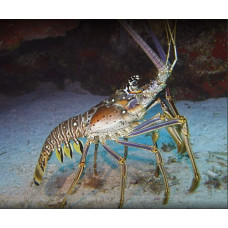Achelata are members of the Decapoda order of crayfish (Decapoda). The body length is up to 60 cm. The body and antennae are covered with numerous spines. The walking legs usually have no claws. The abdominal legs are short and weak. Inhabit mainly warm waters. Achelata are fisheries and breeding species.
Large crustaceans with flattened bodies, reaching up to 60 cm in length. Externally, they resemble lobsters, differing in the absence of massive claws on the front legs. Small claws are present only in females (on the fifth pair of legs) and are used by them to clean the surface of the body. In males of Achelatalangustovs of genus Justitia subclaws are developed on the front pair of walking legs. Body and thick antennae are covered with powerful spines.
They reproduce sexually, reaching sexual maturity by the fifth year of life. Females lay eggs in a special pouch located in the chest area, where they are fertilized by sexual products of males. From fertilized eggs, which are several months in the pouch of the mother, hatch flattened larvae - phyllosomes (from the ancient Greek φῠ́λλον - leaf and σῶμα - body), very small and able to move in the water column thanks to the outgrowths on the body. Externally, they resemble flattened glass spiders, which are difficult to see in the water column. The only thing that reminds of the origin of Achelata larvae is a tiny tail, similar to the tail of an adult lobster. During this period of their life, Achelata larvae feed on benthos (zooplankton) and grow quite rapidly. Gradually they turn into tiny Achelata and sink to the bottom of the sea. In the first year of life, Achelata molt about ten times. The new shell hardens within 2-3 weeks. The lobster's lifespan is unknown.
Achelata are distributed in warm seas. They lead a bottom life at a depth of no more than 200 meters, hiding among rocks, coral structures and in rock crevices, as well as in thickets of underwater vegetation. Crawfish meat is considered a delicacy.
Achelata
Tags: achelata



